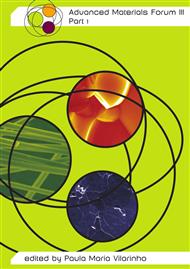p.980
p.985
p.990
p.995
p.1000
p.1005
p.1010
p.1015
p.1020
Physicochemical Characterization of Novel Chitosan-Soy Protein/ TEOS Porous Hybrids for Tissue Engineering Applications
Abstract:
In this paper we report a new type of cross-linked porous structure based on a chitosansoy protein blend system developed by means of combining a sol-gel process with the freeze-drying technique. The final structure was investigated by Fourier transform infrared spectroscopy with attenuated total reflectance (FTIR-ATR), contact angle measurements and the morphology by scanning electron microscopy (SEM). The water uptake capability and the weight loss were measured up to 14 days and their mechanical properties were assessed with compression tests. Results showed that the addition of tetraethyl orthosilicate (TEOS) to the chitosan-soy protein blend system provide specific interactions at the interface between the two polymers allowing to tailor the size and distribution as well as the degradation rate of the hybrids. Finally, TEOS incorporation induces an increase of the surface energy that influences the final physicochemical properties of the materials.
Info:
Periodical:
Pages:
1000-1004
Citation:
Online since:
May 2006
Authors:
Price:
Сopyright:
© 2006 Trans Tech Publications Ltd. All Rights Reserved
Share:
Citation:


